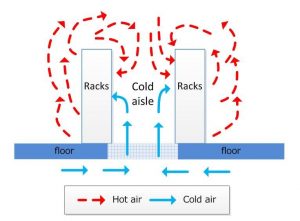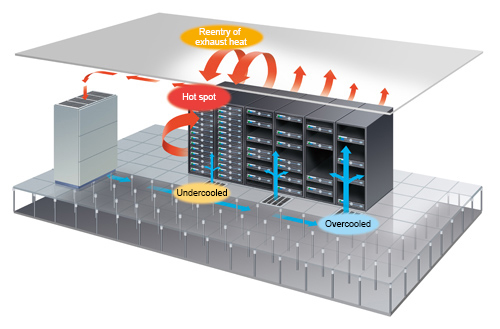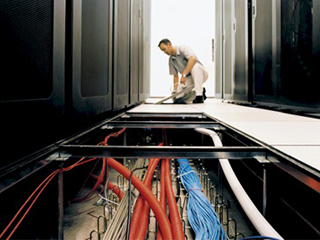Air management for data centers may seem to be a complicated process. But, in principle, it does not have to be.
Datacenter airflow management should follow a fundamental principle. All IT hardware should only take cool air. This principle however often ends with overcooling some areas of the data center in an effort to keep those hot spot areas at the right temperature. The trick for efficiency is to eliminate the hotspots, without overcooling. Managing the airflow, making sure the cold air gets to where it needs to be therefore is an important consideration for a data center administrator.
However, many data center managers are still grappling with
implementing streamlined air management. This is because a significant investment is necessary to upgrade cooling capacities. It will also be an added expense to reconfigure the data center layout.
How can IT managers hurdle such issues? Are there specific methods to manage airflow better? These are valid concerns that need utmost action.
Data Center Air Management
In general, air management is calculated to maintain favorable temperature setpoints in an IT facility. Airflow is a crucial variable in data center operation. Poor airflow will pave the way for overheating of IT equipment. This is because cool air could not circulate, leaving the warm air to be trapped in particular spaces.
Air Management of data centers specifically addresses issues on airflow dynamics. This includes solutions that will facilitate controlled air streams from cooling units to that of the IT hardware. In effect, room temperatures are controlled, thereby creating better air circulation mechanics.
As part of air management, there are primary parts of a data center that need utmost monitoring.
Floors

Photo Credit: betterbuildingssolutioncenter.energy.gov
The floor is one of the primary considerations in temperature control for a data center. It isn’t easy to facilitate better airflow with standard floors. On the other hand, the raised floor has leaking issues to watch as well.
While floor configurations have their pros and cons, specific monitoring indicators are necessary regardless of setup. Allowing better circulation of air is vital for data center floor design. It is only in assisting air to stream properly will environmental parameters be controlled.
Racks and Cabinets
Racks are the backbone that supports your data servers. These are equipment that should allow IT servers to run smoothly. The issue about racks as primary airflow management consideration stems from its physical setup.
With poor rack fitting, spaces are created that are potential air pockets. Such occurrence increases trapped air, which, in turn, results in hotspots. Negating the capacity to track such issues would lead to significant temperature concerns.
Rows
Similar to IT racks, rows are a valuable physical arrangement that promotes better spatial efficiency. However, certain preconditioned are a must for airflow efficiency. Separating aisles into sections to facilitate hot and cold air respectively enhances airflow circulation. Customized aisle arrangements will improve temperature control consequently.
Room
While streamlining the smaller components of a data center, it is also crucial to consider the most significant data center component: the IT room. IT rooms serve as housing to all your IT setup. It is only proper to polish up the airflow controls in it actively.
The more exhaustive airflow management techniques are intended to bigger components. As such, IT rooms are crucial variables in a comprehensive airflow management strategy. Any airflow improvement in the whole room will significantly affect the smaller variables such as the racks and rows.
Common Airflow Issues
Making significant strides in monitoring airflow controls in the data center parts will mean better and customized solutions for specific airflow issues. Poor air management from the vital data center parts gives rise to some common air concerns. These concerns will primarily impact the whole data center operation.
-
Bypass Air
Bypass airflow refers to air dynamics where cooled air does not pass an IT equipment before it goes back to the cooling unit. Bypass air cuts off the basic premise of good air management. It does not stream through IT hardware, negating the capacity of the equipment to cool.
Bypass airflow is a common issue faced by IT managers. Action steps to reduce its occurrence are as follows:
-
seal all possible air gaps in a raised floor setup
-
cover cable cut-outs found in cabinets, especially at the discharge outlet of servers
-
remove and relocate air grills to purposely navigate conditioned air where it is necessary
-
control air velocities at a favorable condition to not risk air shoot up affecting the cabinet setup
-
monitor computer room air-conditioning running time (CRAC units); take note of its downtime as they are the very source of air bypass
-
Recirculation Air

Photo Credit: www.researchgate.ne
Opposite to bypass air dynamics, recirculation of air is also a cause of concern. Recirculation happens when supply air passes through the IT equipment, thereby removing heat. The trouble arises when that air is re-ingested by the IT hardware. Because air recirculated, it picked it up more heat that is, in turn, streamed to the IT equipment. This will compound the high temperature there.
Addressing the problem of recirculating air is similar to bypass airflow management. The action steps can provide the following simple solution:
-
seal the gaps between IT racks, especially in server inlets, to close warm air re-entry
-
ensure adequate supply of cold air to server inlets
-
facilitate sufficient air velocities to stream air adequately towards cabinet servers; cold air should reach the top of IT racks
-
monitor the airflow path to CRAC units; if necessary, install return air plenum or ductwork to ensure proper cold air stream
-
reconfigure IT server arrangement; it is advisable to provide an isolation stream to navigate supply (cold) and return (air) in its proper path
-
remove obstructions in the floor that inhibits cold air supply reaching server inlets
Basic Airflow Solutions
Despite specific solutions aimed at common airflow issues, there are general action steps to smoothen air management. Note that the central premise of airflow management is to take in cold air while streaming out the warm. As such, the goal of air circulation requires that cold air be contained, reaching the hot IT equipment. Containing cold air to channel it to hot IT should end with warm air dispersing out of server inlets.
These air regulations will need some standard tools to achieve a good airflow management dynamic.
The bristles of brushed grommets help prevent air leakage. These are handy tools to block out small debris that can add to air particulate matter. Brush grommets allow cables to be installed while providing enough bristly blocks to inhibit air escape.
Similar to the function of brush grommets, curtains are an easy install option to regulate airflow. The draped cloth can seal hot and cold aisles, aiding the controlled navigation of cold and warm air. Its most significant advantage is it’s an accessible add-on that can be sourced easily.

Photo Credit: www.eaton.com
Often when cold air streams to IT cabinets, hot air rises. With no outlet to disperse, hot air sits on top of IT hardware. Such conditions will muddle the cold temperature of IT racks. Installing a rack chimney is a nifty option to navigate warm air while funneling it to air ducts.
One of the main hurdles in air management is empty pockets and spaces. If these are not closed, inner rack recirculation is of high probability. When there is internal rack recirculation, temperatures setpoints will fluctuate. Filling these empty spaces with blanking panels will limit air space take-up. As a result, this will negate potential circulation issues.
Enhancing Airflow Management through Improved Monitoring
General solutions to limit airflow issues can only be truly effective with a sound monitoring pursuit. The physical installation and add-ons can only do so much. A step ahead of comprehensive airflow management is realizing the crucial part of monitoring the data center and its components.
There are monitoring solutions that can enhance any airflow management activity. It will aid in modernizing, customizing, and reforming a standard data center operation.
AKCP Rack+ Data Center Sensors
An innovative rack solution is a comprehensive monitoring tool that is capable of intelligent solutions. It is easy to deploy without additional cabling needs that will expand a monitoring capacity. Intelligent solutions include:
AKCP Airflow Sensor
Monitoring the status of flowing air is vital in every monitoring checklist. This is further enhanced by AKCP Airflow Sensors that are capable of remote monitoring. Getting alarm notifications is a beneficial add-on to locate and describe airflow faults properly.
Cabinet Thermal Map
Thermal mapping of IT cabinets gets easier with 3x temperature sensors in the front and 3x in the rear. Having this setup ensures that airflow intake and exhaust are monitored precisely. AKCP temperature sensors are standard calibrated to provide the most precise reading. Integrate thermal maps with AKCPro Server software for better monitoring interface.
Simplifying Airflow Management
They say the simpler, the better. This is true even with the air management of data centers. While it is evident that airflow issues are not confined to bypass, and recirculating air, the premise for data air management is fairly simple. Even with general airflow solutions complemented with a sound monitoring technology, airflow management will be less complicated.
Reference Links:
https://www.facilitiesnet.com/datacenters/article/Improving-Data-Center-Air-Management–11487
https://dataspan.com/blog/stop-complicating-data-center-airflow-management/
https://www.upsite.com/blog/effects-of-data-center-hot-air-re-circulation/
https://www.upsite.com/blog/bypass-airflow-simple-may-think/








